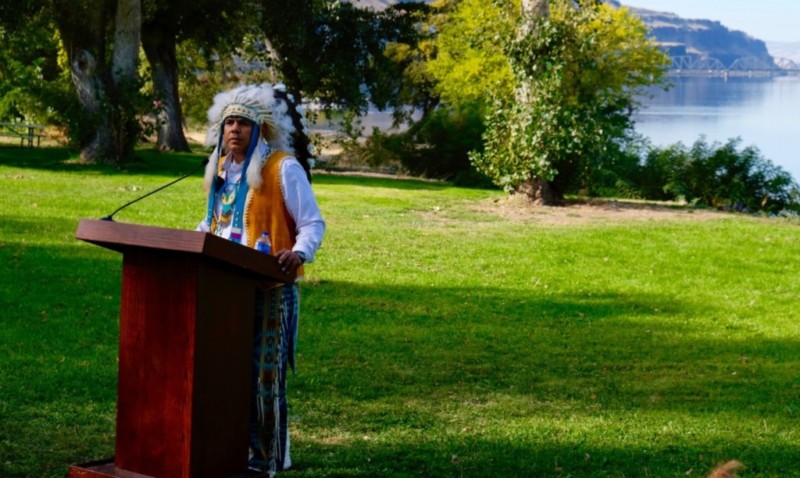Yakama, Lummi Nations call for the removal of three Lower Columbia dams.

Yakama Chairman Joe DeGoudy speaks at Celilo Park on Oct. 14. Photo by Dac Collins
By Dac Collins. Oct. 17, 2019. Tribal leaders and elders from the Yakama and Lummi Nations gathered at Celilo Park on Monday, Oct. 14, in honor of Indigenous People’s Day. News cameras rolled and shutters clicked in the foreground as they spoke at length to the crowd that was gathered there.
They spoke of a broken system rooted in the Doctrine of Discovery, of water that is too hot for salmon, and a worldview that favors progress and profits above all else.
Behind them, the big, sleeping pool of a river was dead calm, and its surface shone like glass. (And while everyone present knew and acknowledged what lie buried beneath that giant pool, only a few of them had ever seen it with their own eyes.)
Yakama elders Karen Jim Whitford, Wilbur Slockish Jr. and Johnny Jackson spoke, as did Celilo Village Chief Olson Meanus. Jay Julius, Chairman of the Lummi Nation, travelled all the way from Bellingham to represent the people of the Salish See. But it was Yakama Chairman Joe DeGoudy who gave the first speech of the day. And his words carried weight.
DeGoudy focused on the history of the colonization, and what he called the subsequent domination, of the Columbia River Basin — a thread that begins with Cristopher Columbus’ “discovery” and Captain Robert Gray’s placement of the American flag on the North bank of the Columbia, and continues through a series of landmark U.S. Supreme Court cases and re-negotiated treaties to the present-day actions of Congress.
As he spoke, his voice was occasionally drowned out by the raucous, rattling sound of a passing train.
Every now and again he would point to the river that stretched out behind him. “It almost looks like a lake,” he said at one point, referring to the water that for the past 62 years has been held back and effectively yoked by a wall of highly engineered concrete further downriver.
It wasn’t until the latter half of this history lesson that DeGoudy arrived at the point in time when the first dam was constructed on the main stem of the Columbia River. From there, he talked about the dam-building era that flourished during the mid-20th century, citing the series of decisions made (and Acts passed) by Congress that transformed the free-flowing river that his ancestor’s knew into the mechanized body of water that we now utilize.
“So here’s the question of today’s day,” DeGoudy said, his voice building with momentum like a wave in deep water.
“What legal basis did the United States have to dam the Columbia River, the Nch’i-Wána, and to impair the Yakama Nation’s treaty-reserved fishing sites at all usual and accustomed places without first obtaining Yakama Nation’s free, prior and informed consent? Under what basis did that happen?”
“…and what will we collectively do about the understanding of what the truth is of history?” he asked.
“The truth,” he repeated, his voice now a visible swell that rolled toward the silent crowd.
[perfectpullquote align=”full” bordertop=”false” cite=”” link=”” color=”” class=”” size=””]“Because these actions of the assertion of so-called original claim, title, domination have never been repudiated. They still govern today. They still rule today…and the Native people’s way of life has faded, and something else has been developed.”[/perfectpullquote]
With these words, the wave crested. And for a brief moment — time enough for a pregnant pause — it seemed to hang over the crowd before the weight of the Chairman’s next statement brought it crashing down.
“Today,” he said, “Yakama Nation, with its allies, are calling upon the United States for the removal of Dalles Dam. For the removal of Bonneville Dam. For the removal of John Day Dam.”
Meanwhile, roughly 9 river miles downstream of Celilo Park, a steady flow of water rushed through the turbines of the Dalles Dam, generating electricity for a power-hungry culture that had long forgotten how to exist without it. At the same time, a westbound barge filled with Idaho-grown wheat passed through a navigation lock on its way to an export terminal, where the bushels of grain would eventually be shipped off to Asian buyers on the far side of the Pacific.
And up in the control room, a crew of U.S. Army Corps. of Engineers employees ensured that this whole process ran smoothly while a number of their co-workers took a paid holiday in honor of Columbus Day.






